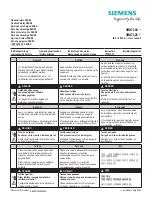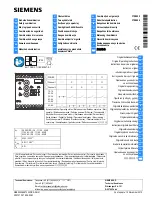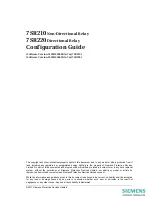
BE1-51/27R - Installation
4-13
SETTING THE RELAY
General
Phase time overcurrent elements (BE1-51/27R relays) can be coordinated with external protection in a
conventional manner by assuming that the pickup current is 25 percent of nominal. This is the case when the
restraint voltage is 25 percent or less. When the restraint voltage exceeds 25 percent, pickup current exceeds
25 percent of nominal and the relay is slower than if pickup current was fixed at 25 percent. Assuming a fixed
25 percent pickup simplifies calculations and provides an added safety margin because the BE1-51/27R relay
is the last step in the coordination for an external fault.
Neutral (ground) time overcurrent and all instantaneous overcurrent functions operate independently of the
voltage control circuits. Therefore, these elements (overcurrent functions) can be set in the normal manner.
They are set independently of each other except that the instantaneous setting is 1 to 40 times the associated
time overcurrent element pickup. The instantaneous element pickup should be set for at least 120 percent of
the maximum current that can be seen by the relay for an external fault where operation is not desired.
Neutral time overcurrent pickup must be set above the maximum expected normal unbalance. Also, for
residually connected elements, added relay current can result from dissimilar errors in the three current
transformers. These errors are greater for the lower accuracy class current transformers. A neutral element
pickup of ten percent of the circuit rating will ordinarily be above non-fault unbalances for a solidly grounded
system. Lower settings are appropriate and safe for impedance grounded systems or for ungrounded protected
equipment connections.
When choosing the time delay setting in a generator back-up application, for a motor starting application, or
during acceleration after a fault is cleared, the limiting condition may be the percentage of generator rating that
is motor load and not coordination for an external fault. The percentage of generator rating that is motor load
needs to be considered when setting the relay.
A nominal phase time overcurrent pickup (with rated restraint voltage) of 200 percent of generator rating can
prevent undesirable tripping during a severe recoverable swing. This pickup is still low enough to provide
sufficient sensitivity for faults.
Relay Setting Concepts
Figure 4-14 plots fault current in multiples of generator rating (assuming no voltage regulator boosting) and relay
pickup as a percent of nominal. The relay tap must be selected so that pickup in multiples of generator rating
is less than the fault current shown in the Figure 4-14 example.
Restraint voltage (V) is proportional to the drop across external reactance (X
E
), and decays along with the fault
current (I) that is developed by the generator. Initial voltage is 40 percent of rated, so the phase time overcurrent
pickup is also 40 percent of nominal. At about 0.04 seconds after fault inception, restraint voltage drops below
25 percent and the pickup current flattens to 25 percent. During the shaded portion of the graph, the relay
operates slower than it would if the pickup current was constant at 25 percent of nominal. This occurs for a very
small time interval compared to the total relay operating time, so the increased pickup has a negligible effect on
operating time.
















































